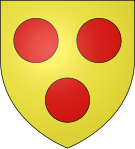| This article relies largely or entirely on a single source. Relevant discussion may be found on the talk page. Please help improve this article by introducing citations to additional sources. Find sources: "Count of Boulogne" – news · newspapers · books · scholar · JSTOR (November 2014) |

Count of Boulogne was a historical title in the Kingdom of France. The city of Boulogne-sur-Mer became the centre of the County of Boulogne during the ninth century. Little is known of the early counts, but the first holder of the title is recorded in the 11th century.
Eustace II of Boulogne accompanied William I of England (the Conqueror) during the Norman Conquest in 1066 and fought on his side at the Battle of Hastings. His son, Eustace III, was a major participant in the First Crusade with his younger brothers: Geoffrey and Baldwin (who later became King of Jerusalem). After Baldwin's death the throne was offered to Eustace, who was reluctant and declined; the throne was then offered to Geoffrey. Afonso (also King of Portugal) from Dammartin became Count of Boulogne from 1235 to 1253.
Count Renaud of Boulogne obtained the title by abducting and marrying Countess Ida in 1190 and later gained title to Dammartin and Aumale. An early friend of King Philippe II Augustus, he turned against the king by joining the forces of the Holy Roman Empire at the Battle of Bouvines in 1214 (where he was defeated, captured, imprisoned and committed suicide).
Boulogne came under nominal royal control in 1223, when it passed to Philippe Hurepel ("spiked hair", the son of Philippe II). Hurepel participated in the Albigensian Crusade in 1226 and later revolted in 1229 against Blanche of Castile. He was slain by Count Dietrich V of Cleaves in 1234, according to sources after accidentally killing Count Florent IV of Holland in a tournament. The county reverted to the crown and was passed to Adelaide of Brabant, wife of William III of Auvergne.
Boulogne was attacked and besieged a number of times during the Hundred Years' War and repeatedly passed between the English and the French. In 1477, Bertrand VI of La Tour gave the county to Louis XI, who incorporated the county into France. Boulogne remained part of France, except for a brief period of English rule under Henry VIII.
William I of Blois (c. 1137 – 11 October 1159) was Count of Boulogne (1153–1159) and Earl of Surrey jure uxoris (1153–1159). He was the third son of King Stephen of England and Countess Matilda I of Boulogne.
List of counts
Uncertain
- ?–921? : Erkenger
House of Flanders
For a complete table of rulers, see House of Flanders § Rulers.
- 896–918: Baldwin I (also count of Flanders)
- 918–933: Adelolf (son)
- 933–964: Arnulf I (brother; also count of Flanders)
- 964–971: Arnulf II (nephew; son of Adelolf)
- 971–990: Arnulf III (son)
- 990–1025: Baldwin II (son)
- 1025–1049: Eustace I (son)
- 1049–1087: Eustace II (son)
- 1087–1125: Eustace III (son)
- 1125–1151: Matilda I (daughter)
House of Blois
Further information: House of Blois § Rulers
- 1125–1151: Stephen (husband; also Count of Mortain, Duke of Normandy and King of England)
- 1151–1153: Eustace IV (son; also Count of Mortain)
- 1153–1159: William I (brother; also Count of Mortain and Earl of Surrey)
- 1159–1170: Mary I (sister; married Matthew of Alsace)
House of Alsace

- 1170–1173: Matthew
- 1173–1216: Ida (daughter)
- 1181–1182: Gerard (first husband)
- 1183–1186: Berthold (second husband)
- 1191–1216: Renaud of Dammartin (third husband)
House of Dammartin

- 1216–1259: Matilda II (also Queen of Portugal, Countess of Mortain, Countess of Aumale and Countess of Dammartin)
House of Auvergne

- 1262–1265: Adelaide (cousin; married William III, Count of Auvergne)
- 1265–1277: Robert I (son; also Count of Auvergne)
- 1277–1277: William II (son; also Count of Auvergne)
- 1277–1314: Robert II (brother; also Count of Auvergne)
- 1314–1325: Robert III (son; also Count of Auvergne)
- 1325–1332: William III (son; also Count of Auvergne)
- 1332–1360: Joanna I (daughter; also Countess of Auvergne); married:
- 1338–1346: Philip of Burgundy
- 1350–1360: John II of France
House of Burgundy

- 1360–1361: Philip III (son; also Duke of Burgundy, Count of Auvergne, Count of Artois and Count of Franche-Comté)
House of Auvergne
- 1361–1386: John II (cousin; also Count of Auvergne)
- 1386–1404: John III (son; also Count of Auvergne)
- 1404–1424: Joanna II (daughter; also Countess of Auvergne); married:
- 1424–1437: Mary II (cousin; also Countess of Auvergne)
House of La Tour d'Auvergne

- 1437–1461: Bertrand I (son; also Count of Auvergne)
- 1461–1477: Bertrand II (son; also Count of Auvergne)
In 1477, Bertrand II dealt with Louis XI, exchanging the county of Boulogne with the county of Lauragais. Boulogne, so became part of the royal domain.
See also
References
- "Joseph Vaesen e Étienne Charavay, Lettere di Luigi XI , vol. 6, Parigi, Biblioteca Renouard,1898, P. 159-160". Paris, Librairie Renouard, H. Loones, successeur. 1883.
- Fortanier, Jean Ramière de (January 1932). Les droits seigneuriaux dans la sénéchaussée et comté de Lauragais (1553-1789) : étude juridique et historique. FeniXX. ISBN 978-2-307-61430-2.
- Histoire généalogique de la maison d'Auvergne, Livre troisième, page 91 et seq. 1645.